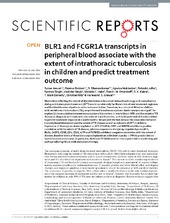| dc.contributor.author | Jenum, Synne | en_US |
| dc.contributor.author | Bakken, Rasmus | en_US |
| dc.contributor.author | Sivakumaran, Dhanasekaran | en_US |
| dc.contributor.author | Mukherjee, Aparna | en_US |
| dc.contributor.author | Lodha, Rakesh | en_US |
| dc.contributor.author | Singh, Sarman | en_US |
| dc.contributor.author | Singh, Varinder | en_US |
| dc.contributor.author | Haks, Marielle C. | en_US |
| dc.contributor.author | Ottenhoff, Tom H.M. | en_US |
| dc.contributor.author | Kabra, Sushil K. | en_US |
| dc.contributor.author | Doherty, Timothy Mark | en_US |
| dc.contributor.author | Ritz, Christian | en_US |
| dc.contributor.author | Grewal, Harleen | en_US |
| dc.date.accessioned | 2017-08-04T11:28:12Z | |
| dc.date.available | 2017-08-04T11:28:12Z | |
| dc.date.issued | 2016-12-12 | |
| dc.Published | Jenum S, Bakken R, Sivakumaran D, Mukherjee A, Lodha R, Singh S, Singh V, Haks MC, Ottenhoff TH, Kabra SK, Doherty TM, Ritz C, Grewal H. BLR1 and FCGR1A transcripts in peripheral blood associate with the extent of intrathoracic tuberculosis in children and predict treatment outcome. Scientific Reports. 2016;6:38841 | eng |
| dc.identifier.issn | 2045-2322 | |
| dc.identifier.uri | https://hdl.handle.net/1956/16215 | |
| dc.description.abstract | Biomarkers reflecting the extent of Mycobacterium tuberculosis-induced pathology and normalization during anti-tuberculosis treatment (ATT) would considerably facilitate trials of new treatment regimens and the identification of patients with treatment failure. Therefore, in a cohort of 99 Indian children with intrathoracic tuberculosis (TB), we performed blood transcriptome kinetic analysis during ATT to explore 1) the association between transcriptional biomarkers in whole blood (WB) and the extent of TB disease at diagnosis and treatment outcomes at 2 and 6 months, and 2) the potential of the biomarkers to predict treatment response at 2 and 6 months. We present the first data on the association between transcriptional biomarkers and the extent of TB disease as well as outcome of ATT in children: Expression of three genes down-regulated on ATT (FCGR1A, FPR1 and MMP9) exhibited a positive correlation with the extent of TB disease, whereas expression of eight up-regulated genes (BCL, BLR1, CASP8, CD3E, CD4, CD19, IL7R and TGFBR2) exhibited a negative correlation with the extent of disease. Baseline levels of these transcripts displayed an individual capacity >70% to predict the six-month treatment outcome. In particular, BLR1 and FCGR1A seem to have a potential in monitoring and perhaps tailoring future antituberculosis therapy. | en_US |
| dc.language.iso | eng | eng |
| dc.publisher | Nature Publishing Group | eng |
| dc.rights | Attribution CC BY | eng |
| dc.rights.uri | http://creativecommons.org/licenses/by/4.0 | eng |
| dc.title | BLR1 and FCGR1A transcripts in peripheral blood associate with the extent of intrathoracic tuberculosis in children and predict treatment outcome | en_US |
| dc.type | Peer reviewed | |
| dc.type | Journal article | |
| dc.date.updated | 2017-05-10T09:03:38Z | |
| dc.description.version | publishedVersion | en_US |
| dc.rights.holder | Copyright 2016 The Author(s) | |
| dc.identifier.doi | https://doi.org/10.1038/srep38841 | |
| dc.identifier.cristin | 1421999 | |
| dc.source.journal | Scientific Reports | |

